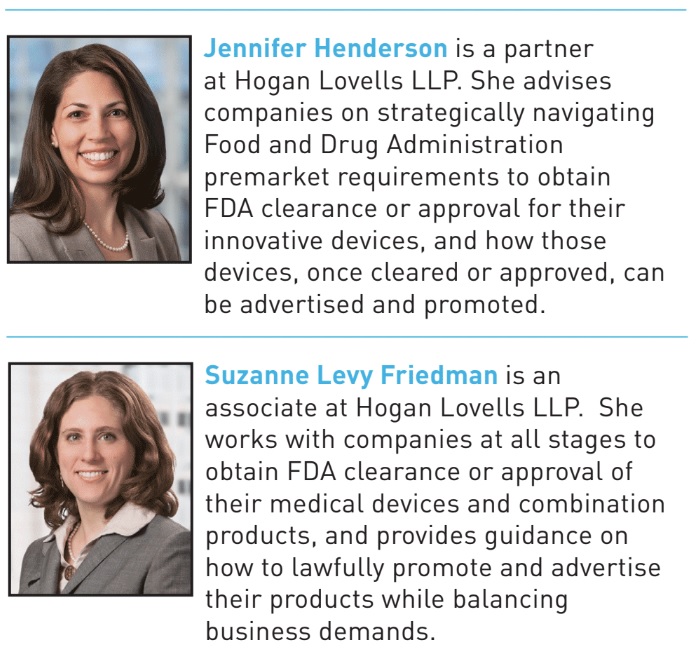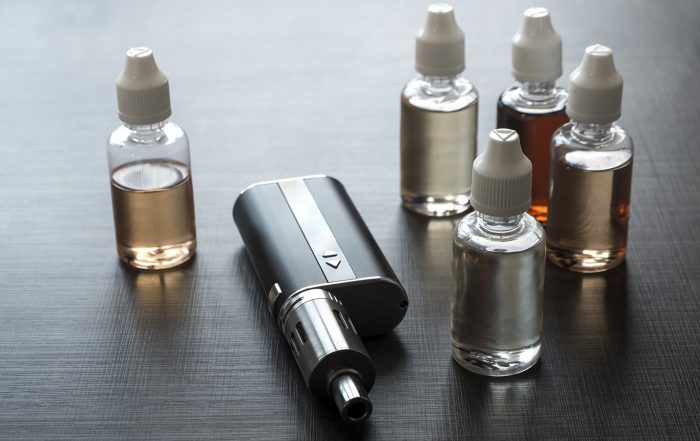
Medical Device Crowdfunding and Pre-Approval Promotion:Where Does FDA Draw the Line?
by Jennifer Henderson and Suzanne Levy Friedman
The medical device industry has long sought more comprehensive guidance from the Food and Drug Administration (FDA or the agency) regarding the line between appropriate and inappropriate pre-approval communications. Industry seeks clarity to be able to confidently navigate communications in the pre-approval stage without running afoul of the prohibition against promotion and commercialization of uncleared/unapproved medical devices. The emerging practice of crowdfunding medical devices raises new issues about what constitutes pre-approval promotion, and where the line for permissible communications might fall.
FDA’s Current Framework on Pre-Approval Communications
FDA has a longstanding prohibition against marketing uncleared or unapproved medical devices which is derived, at its core, from the Federal Food, Drug, and Cosmetic Act (FDCA).
Specifically, the FDCA prohibits manufacturers from misbranding and adulterating their products through labeling that is “false or misleading in any particular,” promotion for uses that have not been cleared or approved, or distribution for such purposes.1 In short, the FDCA forbids the commercialization of medical devices that lack the appropriate 510(k) clearance or premarket approval (unless exempted), as well as promotion of medical devices for uncleared or unapproved uses. Commercial distribution can include many types of activities, such as advertising or otherwise offering for sale a device for a specific intended purpose, discussing pricing or contract terms, entering into distribution agreements, and discussing when the product will be available. Promotion includes any activity intended to facilitate the sale of a device, such as making its labeling publicly available, disseminating materials or making oral claims about the product, and talking about, presenting, or demonstrating its capabilities at public forums.
Nevertheless, FDA recognizes that manufacturers need to be able to communicate with certain audiences in certain situations about their uncleared/unapproved devices. To that end, the agency has, over the years, provided discrete guidance allowing very circumscribed types of pre-approval communications (i.e., limited to certain audiences and objectives) in a manner that remains consistent with its position that communications to the general public or potential patients/users regarding uncleared/unapproved medical products is inappropriate. These include, for example:
- Communications and trade show displays about 510(k)-pending devices per Compliance Policy Guide (CPG) 300.600, Commercial Distribution with Regard to Premarket Notification (510(k)), which establishes that the same criteria for determining whether a device is “pre-amendments” are relevant to assessing preclearance promotional activities. Specifically, “[a]lthough a firm may advertise or display a device that is the subject of a pending 510(k) – in the hope that FDA will conclude that the device is substantially equivalent to a pre-amendments device – a firm may not take orders, or be prepared to take orders, that might result in contracts of sale for the device unless limited to research or investigational use.”2
- Communications to recruit investigators and study subjects to participate in clinical studies of investigational devices. Such messaging must refrain from any potential coercion.
- Communications with payors regarding investigational devices.3 In this targeted context, companies may share certain information for budgeting and related purposes (e.g., anticipated timeline for potential FDA clearance/approval).4
- Communications with investors and the financial community. Messaging is permitted to a limited audience (e.g., separately designated on the firm’s website) to enable companies to gauge their inventions’ marketability and obtain financial support to bring them to fruition.
- Coming Soon ads are permitted to raise awareness by merely announcing the upcoming availability of a new product without specific information.
Of note, the limited allowances established by FDA in the above areas are all subject to the same core limitations: companies may not make claims of safety or effectiveness for uncleared/unapproved purposes and must conspicuously disclose the device’s present regulatory status.
Assessing Crowdfunding Activities from an FDA Compliance Perspective
There are two principal types of crowdfunding: (1) rewards-based crowdfunding, where individuals donate to a cause or pre-purchase products but are not granted shares or any stake in the recipient of the funds; and (2) equity/investment crowdfunding, where the funding is tied to an equity interest. Both models allow capital to be raised from a much larger pool of people than was historically possible, in part because contributors need not be accredited investors. At the same time, rewards-based crowdfunding avoids the regulation attached to solicitation of investments from the general public, because there is no actual investment as defined by the courts and federal agencies.5 Instead, individuals are asked to make donations targeted for a particular product (as opposed to the growth of a company and its potential initiatives), often for a physical reward, such as early access to the invention in question.
Crowdfunding websites dedicated to raising money for new ventures present an opportunity for companies to showcase uncleared/unapproved medical devices, whether only at the concept stage or closer to a final finished device, and to promote, promise, or even provide such devices to consumers. Associated activities and statements may thus raise many of the same fundamental issues regarding pre-approval promotion and commercialization as others that have long been on FDA’s radar, but also generate some unique considerations.
Specifically, the use of videos, images, and claims about what the device will be able to do may constitute inappropriate display, advertising, or promotion of a device for a specific intended purpose. Also worth noting in this regard is that many crowdfunding campaigns feature devices not yet at the 510(k)-pending stage discussed in the CPG, so their promotion may be viewed as even less acceptable (at least from a strict regulatory perspective), unless the device is more of a concept than close to reality. Delivering an uncleared/unapproved device or promising to deliver it once it is cleared/approved, in exchange for the financial contribution, could certainly be tantamount to taking orders or [preparing for] selling a device (i.e., generating a list of customers) without marketing authorization. By contrast, if the crowdfunding campaign does not promise a particular device and/or is not tied to a specific device at all (e.g., if the fundraising is for early research and development, or only to support a regulatory submission), the risk of FDA’s taking issue may well be lower. From a more general advertising and promotion standpoint, crowdfunding also has a non-specific audience likely to be comprised primarily of laypersons; this makes the communication akin to direct-to-consumer (DTC), which has historically triggered higher regulatory scrutiny from FDA because lay consumers are not expected to be as knowledgeable as healthcare professionals in assessing the benefits and risks of a given device.
So, what happens when the public at large, which is generally an audience that FDA considers to be an inappropriate target for pre-approval communications outside of the very circumscribed scenarios noted above, becomes your investor pool? Which of the existing limited allowances for pre-approval communications apply, if any? To date, FDA has not issued a specific policy outlining how the agency intends to assess pre-approval communications and distinguish between what is appropriate and what is not in the context of crowdfunding campaigns. Indeed, FDA has signaled that it intends to rely on its existing regulatory framework, tailoring it to this particular application where needed.6 As such, when assessing crowdfunding for medical devices, companies should consider the existing legal framework, existing agency policies where there may be parallels, and any cases where FDA has either taken enforcement action (we are not aware of any Warning Letters to date specific to crowdfunding activities) or appears to have intervened. The following examples can provide insight and illustrate key themes.
In 2013, Scanadu quickly raised over $1.6 million from over 8,500 backers through an Indiegogo campaign for its Scout device, which was intended to record vitals such as heart rate and skin temperature and wirelessly transmit this information to a smartphone app and optionally to health care providers. The campaign offered various levels of contribution, from merely being kept informed to receiving the product after FDA clearance. This case highlights the intersection between crowdfunding and established requirements for investigational devices, as the Scout was actually provided, pre-clearance, to backers who consented to participate in a usability study to support its development and ultimate regulatory filing. Although shipment of the Scout was made conditional on study participation, FDA regulations obligate companies to give clinical study participants the opportunity to opt out at any time.7 In such a scenario, it is unclear how a company could enforce any requirement that the device be shipped back; thus, it may be viewed as facilitating consumers’ reliance on an un-reviewed product, raising precisely the risks about which FDA is concerned. Providing the investigational device could also be viewed as an improper inducement to participate in the study, violating human subject protections. The Scout was never cleared, with backers informed in late 2016 that the project had been abandoned.8
In May 2015, Cur launched a crowdfunding campaign for its transcutaneous electrical nerve stimulation (TENS) device intended to relieve muscle and nerve pain, an indication that requires FDA clearance. The company posted videos demonstrating how the device works and offers of discounted sales (i.e., to invest only $149 for a product valued at $299). Shortly after an online publication called out the regulatory risks of its campaign, Cur clarified that devices would not be shipped to backers prior to FDA clearance. This case exemplifies the risks of tying a crowdfunding contribution directly to delivery of a device, i.e., it is liable to be perceived as a purchase. While the website included a disclaimer intended to protect against these arrangements being perceived as pre-ordering, indicating that funding the campaign represented “contributing (i.e., making a donation) to a work in progress and not making a direct purchase. …”,9 FDA has never considered disclaimers sufficient to cure what is otherwise a violation of its regulations.
In 2016, Tute Genomics launched a crowdfunding campaign that offered to have a backer’s entire genome and exome sequenced and provide a report with information on actionable variants in their DNA and their risks of developing various diseases.10 However, a mere two days later, the company informed backers that FDA had expressed concern with the campaign, which it suspended. This case seems to signal that FDA may be more likely to step in where the crowdfunding platform is used to conduct DTC marketing for a type of device it finds particularly concerning (the agency has long scrutinized promotion/sale of genetic testing without FDA review or physician oversight).
Recently, Upright Technologies crowdfunded a wearable biofeedback device intended to correct posture by vibrating to remind the user to sit straighter. The website for the Upright GO campaign included similar offers of sale as other such campaigns (e.g., contribute a certain amount to obtain it at 43% off retail value), as well as explicit claims of efficacy (e.g., “it really works and we know it,” “prevent backache and muscular pain”).11 While the company appeared to have data supporting its assertions, the device was not, and still is not, FDA-cleared. That FDA does not appear to have intervened despite pre-approval claims that resemble ones to which it has objected in other contexts might derive from the fact that the subject device is intended for “general wellness” type uses as opposed to what are traditionally considered more serious medical claims. Nevertheless, FDA could still consider products in this “gray area”—which many crowdfunded devices are—to meet the statutory definition of a medical device, and the use of explicit and specific effectiveness claims may well render the agency more likely to take note.
Considerations for Compliant Crowdfunding Campaigns
Given consistent, albeit informal, signals that the particular manner in which funds are raised does not alter the rules of the road, the same principles that guide firms regarding any communications surrounding as-yet-unapproved devices suggest factors that may affect the risk that a crowdfunding campaign will be viewed as inappropriate pre-approval promotion/commercialization. FDA’s primary concern with pre-approval communications in the crowdfunding context is that they will lead consumers and potential users to forgo cleared/approved therapies based on the promise of a pipeline product that has not yet been, and may never be, found safe and effective. Accordingly, companies seeking to launch crowdfunding campaigns for medical devices should carefully consider all aspects of the campaign and its website. In addition to assessing compliance per FDA’s general framework, which requires that any such communications be truthful, accurate, and non-misleading, companies should also take into account the following nuanced considerations that may affect the level of regulatory risk that a given campaign may raise:
- Stage of product development. Concept devices may raise less concern than those that are well beyond the development phase but lack a pending 510(k).
- Risk of the featured device. Higher-risk devices are more likely to garner concern from FDA, particularly if promised in exchange for a donation.
- Whether the device’s FDA regulatory status is conspicuously and clearly stated.
- If the device is 510(k)-pending, whether the campaign is consistent with CPG 300.600, including all statements being limited to and consistent with what was submitted to FDA.
- Consistency with FDA’s laws and policies for investigational devices. Where applicable, the campaign should comply with 21 C.F.R. Part 812 (including consideration of the need for IRB review of communications) and the agency’s related 1999 guidance.
- Structure of the investment/donation. Directly tying donations to provision of the device, once cleared/approved, may be viewed as taking orders in violation of the FDCA and CPG 300.600. In contrast, raising funds for early bench testing would likely present less risk of objection. Thus, the campaign should make it clear exactly how contributors’ money will be used.
- Specific content of campaign materials. Limiting information to factual statements about a planned device and the company’s aim will likely concern FDA less than flashy graphics and significant medical claims about safety, efficacy, and/or superiority to marketed alternatives.
Crowdfunding is arguably democratizing medical device innovation, allowing more and different types of companies to enter the space and obtain more diverse and representative feedback on what consumers/patients need or want. Nonetheless, given how close certain associated statements and activities appear to be to crossing the line, and that FDA has demonstrated it is not averse to intervening, it behooves companies considering this vehicle to carefully evaluate how their offers align—or conflict—with what FDA considers to be acceptable pre-approval communications.
Update Magazine
October/November 2018
- FDC Act Sections 501-502.
- https://www.fda.gov/ICECI/ComplianceManuals/CompliancePolicyGuidanceManual/ucm073888.htm. FDA has also applied this policy to 510(k)-pending devices where substantial equivalence is being pursued to a non-pre-amendments device.
- See Preparing Notices of Availability of Investigational Medical Devices and for Recruiting Study Subjects (March 19, 1999), https://www.fda.gov/downloads/medicaldevices/deviceregulationandguidance/guidancedocuments/ucm073585.pdf.
- See Drug and Device Manufacturer Communications with Payors, Formulary Committees, and Similar Entities – Questions and Answers (June 2018), https://www.fda.gov/downloads/drugs/guidancecomplianceregulatoryinformation/guidances/ucm537347.pdf.
- The U.S. Securities and Exchange Commission (SEC) often applies the Howey Test, which defines a transaction as an investment contract or security if there is (1) an exchange of money (2) with an expectation of profits (3) arising from a common enterprise (4) which depends solely on the efforts of a promoter or third party. SEC v. W. J. Howey Co., 328 U.S. 293 (1946).
- Dr. William Maisel, then acting director of FDA’s Office of Device Evaluation, said through a spokesman in 2015 that device companies must follow FDA’s marketing and advertising regulations regardless of how they are raising funds, and did not respond to questions about the legality of specific crowdfunding practices. See “Crowdfunding of medical devices raises money – and questions,” Boston Globe (Sept. 8, 2015), https://www.bostonglobe.com/business/2015/09/07/crowdfunding-medical-devices-raises-money-online-questions-the-fda-hasn-reviewed-these-medical-devices-yet-but-you-can-buythem/RoVuxMgfefPufzuEKYzA4I/story.html.
- See 21 C.F.R. § 50.25(a)(8).
- See “Scanadu to shut down support for its Scout device per FDA regulation and customers are mad”, Sarah Buhr, TechCrunch.com (Dec. 13, 2016); https://techcrunch.com/2016/12/13/fda-orders-scanadu-to-shut-down-support-for-its-scout-device-and-customers-are-mad/. It is not clear whether the project’s end was triggered by any FDA concern, as the agency refused to comment.
- See “Cur is crowdfunding a medical device that isn’t cleared by the FDA, and that’s a problem”, Arielle Duhaime-Ross, The Verge (May 14, 2015), at: https://www.theverge.com/2015/5/14/8599453/cur-crowdfunding-medical-device-fda-tens. There is no evidence that FDA intervened in this case.
- See “Tute Genomics Suspends Kickstarter Campaign Following FDA Letter”, SciPol – Duke University (Oct. 3, 2016), http://scipol.duke.edu/content/tute-genomics-suspends-kickstarter-campaign-following-fda-letter.
- See https://www.kickstarter.com/projects/upright-go/upright-go-fix-your-screen-slouch-correct-your-pos.







